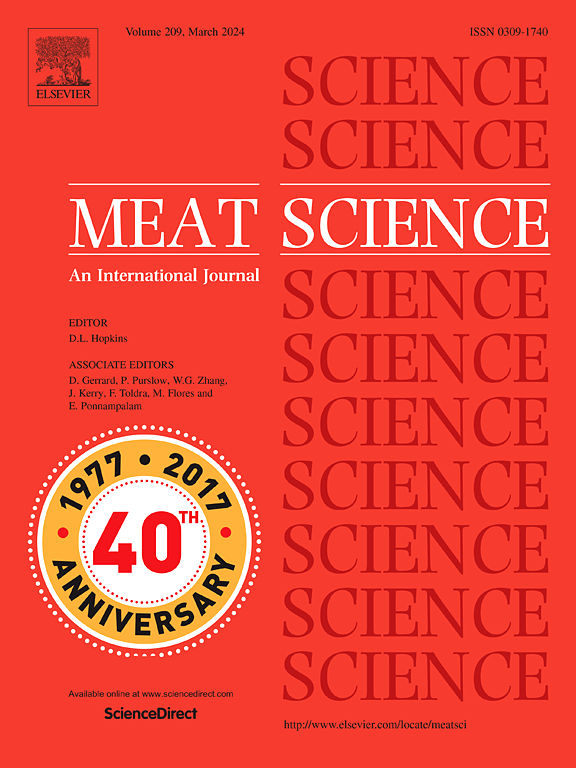红蜂胶提取物作为天然抗氧化剂在冷冻羊肉汉堡中的功效
IF 6.1
1区 农林科学
Q1 Agricultural and Biological Sciences
引用次数: 0
摘要
研究了红蜂胶提取物在- 18°C保存120天的羊肉汉堡中的抗氧化作用。制备的处理分别为CON(对照,无抗氧化剂)、ERI (500 mg/kg赤山酸钠)、P1800 (1800 mg/kg蜂胶提取物)和P3600 (3600 mg/kg蜂胶提取物)。进行的分析包括近似成分(水分、蛋白质、脂肪和灰分)、质地和感官接受度(第0天);pH值、颜色(L*、a*、b*)、蒸煮失重(WLC)、减径、TBARS和过氧化物指数(0、30、60、90和120天);脂肪酸谱和挥发性化合物(0和120天)。没有治疗与近似成分的改变相关。P1800和P3600处理的织构参数较低(P <;0.05),说明提取物有利于提高汉堡的这一感官属性,使汉堡更柔软。WLC在使用提取物的处理中较高;然而,汉堡直径的减小幅度较小,这对消费者来说是一个重要方面。在贮藏过程中,P3600提取物对脂质氧化有抑制作用,其中P3600在贮藏第120天TBARS水平最低(1.37 mg MDA/kg),过氧化指数最低(5.69 mEq g O2)。在CON和ERI处理中,脂质氧化产生的挥发性化合物的存在更为明显,表明P1800和P3600处理中使用的天然抗氧化剂的效率。综上所述,红蜂胶是天然抗氧化剂替代合成抗氧化剂的理想选择。本文章由计算机程序翻译,如有差异,请以英文原文为准。
Effectiveness of red propolis extract as a natural antioxidant in frozen lamb burgers
The antioxidant effects of red propolis extract were evaluated in lamb burgers stored for 120 days at −18 °C. The treatments prepared were CON (control, no antioxidant), ERI (500 mg/kg sodium erythorbate), P1800 (1800 mg/kg propolis extract), and P3600 (3600 mg/kg propolis extract).The analyses performed were proximate composition (moisture, protein, fat, and ash), texture, and sensory acceptance (day 0); pH, color profile (L*, a*, b*), weight loss of cooking (WLC), diameter reduction, TBARS, and peroxide index (0, 30, 60, 90, and 120 days); and fatty acid profile and volatile compounds (0 and 120 days). No treatment was associated with a change in the proximate composition. Most texture parameters in treatments P1800 and P3600 were lower (P < 0.05), and it can be concluded that the extract favors the improvement of this sensory attribute, making the hamburgers softer. The WLC was higher in the treatments where the extract was used; however, the reduction of the diameter of the hamburgers was lower, an important aspect for consumers. The extract retarded lipid oxidation during storage, especially P3600, which presented the lowest level of TBARS (1.37 mg MDA/kg) and the peroxide index (5.69 mEq g of O2) on day 120. The presence of volatile compounds derived from lipid oxidation was more evident in the CON and ERI treatments, showing the efficiency of natural antioxidants used in the P1800 and P3600 treatments. It is concluded that red propolis represents an excellent alternative for replacement of synthetic antioxidants with natural products in lamb hamburgers.
求助全文
通过发布文献求助,成功后即可免费获取论文全文。
去求助
来源期刊

Meat Science
工程技术-食品科技
CiteScore
12.60
自引率
9.90%
发文量
282
审稿时长
60 days
期刊介绍:
The aim of Meat Science is to serve as a suitable platform for the dissemination of interdisciplinary and international knowledge on all factors influencing the properties of meat. While the journal primarily focuses on the flesh of mammals, contributions related to poultry will be considered if they enhance the overall understanding of the relationship between muscle nature and meat quality post mortem. Additionally, papers on large birds (e.g., emus, ostriches) as well as wild-captured mammals and crocodiles will be welcomed.
 求助内容:
求助内容: 应助结果提醒方式:
应助结果提醒方式:


